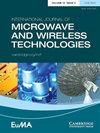In situ resistivity measurement of metal surfaces to track down dislocations caused by high field conditioning
IF 1.3
4区 计算机科学
Q3 ENGINEERING, ELECTRICAL & ELECTRONIC
International Journal of Microwave and Wireless Technologies
Pub Date : 2023-12-22
DOI:10.1017/s1759078723001411
引用次数: 0
Abstract
Conditioning of a metal surface in a high-voltage system is the progressive development of resistance to vacuum arcing over the operational life of the system. This is relevant for accelerator cavities, where high level of performance is only achievable after a long conditioning period. Beyond the accelerator research field, this is an important topic for any technology where breakdowns can cause device failure, either by directly disrupting device operation or by causing cumulative hardware damage. We are developing a direct method to measure the surface resistivity of a metal surface that is being conditioned with a HV DC system by inducing a high frequency (GHz) radio-frequency current in the parallel-plate electrode system. If the system can function as a resonant cavity, the surface resistivity data would be encoded in its quality factor (Q-factor). The changes in the resistivity measured in cryogenic conditions would indicate a formation of dislocations under the surface, something that has been speculated as an important process behind the conditioning. In this paper, we present two modified designs of the electrode system, which will act as a resonant cavity, the results of 3D EM simulations and experimental results regarding the characterization of this resonant system.对金属表面进行原位电阻率测量,追踪高场调节引起的位错
高压系统中金属表面的调节是指在系统的运行寿命期间逐步提高对真空电弧的抵抗能力。这与加速器腔体息息相关,因为只有经过较长的调节期才能达到较高的性能水平。除了加速器研究领域之外,这对于任何技术来说都是一个重要课题,因为在这些技术中,故障会直接中断设备运行或造成累积性硬件损坏,从而导致设备失效。我们正在开发一种直接方法,通过在平行板电极系统中感应高频(GHz)射频电流,测量正在使用高压直流系统调节的金属表面的表面电阻率。如果该系统能发挥谐振腔的作用,则表面电阻率数据将被编码为其品质因数(Q 因子)。在低温条件下测量到的电阻率的变化将表明表面下位错的形成,这被推测为调节背后的一个重要过程。在本文中,我们介绍了两种经过改进的电极系统设计,它们将充当谐振腔、三维电磁模拟结果以及有关该谐振系统特征的实验结果。
本文章由计算机程序翻译,如有差异,请以英文原文为准。
求助全文
约1分钟内获得全文
求助全文
来源期刊

International Journal of Microwave and Wireless Technologies
ENGINEERING, ELECTRICAL & ELECTRONIC-TELECOMMUNICATIONS
CiteScore
3.50
自引率
7.10%
发文量
130
审稿时长
6-12 weeks
期刊介绍:
The prime objective of the International Journal of Microwave and Wireless Technologies is to enhance the communication between microwave engineers throughout the world. It is therefore interdisciplinary and application oriented, providing a platform for the microwave industry. Coverage includes: applied electromagnetic field theory (antennas, transmission lines and waveguides), components (passive structures and semiconductor device technologies), analogue and mixed-signal circuits, systems, optical-microwave interactions, electromagnetic compatibility, industrial applications, biological effects and medical applications.
 求助内容:
求助内容: 应助结果提醒方式:
应助结果提醒方式:


